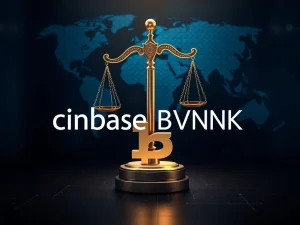Revolutionary Crypto Regulation: SEC Unveils Ambitious Agenda Amidst Coinbase AI Surge

The cryptocurrency world is constantly evolving. Today, significant developments across regulation, technology, and market dynamics captured headlines. These changes impact everyone from institutional investors to individual traders. Understanding these shifts is crucial for navigating the digital asset landscape. We examine the latest insights shaping the future of crypto regulation, technological adoption, and market clarity.
Unpacking SEC’s Bold Crypto Regulation Agenda
US Securities and Exchange Commission (SEC) Chair Paul Atkins recently unveiled a comprehensive regulatory agenda. This plan proposes new rules that could dramatically reshape how the agency approaches digital assets. On Thursday, the SEC released approximately 20 proposed rules. These were part of its spring 2025 agenda. Each proposal carries varying potential impacts on the crypto industry. Many observers suggest the commission aims to soften its enforcement approach. It seeks to establish clearer safe harbors and restructure existing regulations. This could benefit legitimate crypto projects significantly.
Atkins stated, “The agenda covers potential rule proposals related to the offer and sale of crypto assets.” He added that these changes would help clarify the regulatory framework. They would also provide greater certainty to the market. Among the proposed rules are “certain exemptions and safe harbors” for crypto asset offerings and sales. Furthermore, the SEC plans to amend the Exchange Act. This amendment will account for the trading of crypto assets on alternative trading systems (ATSs) and national securities exchanges. These modifications could allow crypto companies to operate with less stringent regulatory oversight. They might also reduce the risk of legal action.
Other proposals suggest modifying “broker-dealer financial responsibility rules.” This could lessen the reporting burden on crypto companies. Broker-dealer rules have historically been a major point of contention. They often impose Know Your Customer (KYC) and Anti-Money Laundering (AML) regulations on networks. Often, these networks lack the inherent means to gather such data. Therefore, these proposed reforms could streamline compliance. They could also foster a more cooperative environment between regulators and the industry. This is a significant step towards a more mature and integrated financial system.
Wintermute’s Crucial Plea for Network Tokens
Leading trading firm and market maker Wintermute has formally urged the US SEC for clarity. Specifically, Wintermute argues that network tokens should not fall under securities regulations. The company submitted its case in a detailed response to the agency’s request for comment. Wintermute emphasized that regulatory certainty is absolutely vital. This certainty prevents the misapplication of securities laws. It also supports the continued development of crypto markets. Without such clear guidance, the firm warned, innovation and adoption in the sector could face unnecessary hurdles.
Wintermute highlighted that network tokens serve as essential technical components. For instance, **Bitcoin** (BTC) and **Ethereum** (ETH) are foundational to blockchain operations. These tokens differ significantly from traditional financial products. They are inherently tied to the functioning of decentralized networks. Therefore, they should not be classified as securities. Misclassifying these utility-driven assets could stifle technological progress. It could also create legal ambiguities for developers and users alike. This distinction is critical for the industry’s growth. It ensures that innovative projects can thrive without undue regulatory burdens.
Source: Wintermute
The firm’s position aligns with many industry stakeholders. They believe that a nuanced approach to digital asset classification is necessary. This approach recognizes the unique characteristics of different token types. Such clarity would foster greater investment. It would also encourage wider adoption of blockchain technology. Consequently, it would establish a more stable and predictable environment for all participants. This move by Wintermute underscores the ongoing dialogue between the crypto industry and regulators. Both sides seek a balanced framework that protects investors while promoting innovation.
Coinbase AI: CEO Armstrong’s Ambitious Integration Goal
Coinbase CEO Brian Armstrong has set an ambitious target for artificial intelligence (AI) integration. Over 40% of Coinbase’s code is currently written by AI. Armstrong hopes this figure will rise to 50% by next month. He posted on X, “Obviously it needs to be reviewed and understood.” He further clarified, “not all areas of the business can use AI-generated code.” However, he stressed the importance of using it responsibly “as much as we possibly can.” This aggressive adoption highlights a broader trend within tech companies.
Source: Brian Armstrong
The percentage of AI-generated lines of code at Coinbase has more than doubled since April. This rapid increase showcases the company’s commitment to leveraging AI. Armstrong’s announcement comes roughly a month after Coinbase revealed a major strategic focus. The company aims to transform its workforce into “AI-Natives.” This initiative signals that Coinbase does not plan to replace a significant share of its 4,200 employees with AI. Instead, it seeks to empower its human workforce with advanced AI tools. This strategy enhances productivity and innovation. It also positions Coinbase at the forefront of technological adoption in the financial sector.
Broader Implications for the Crypto Landscape
These developments collectively paint a picture of a rapidly maturing crypto industry. The SEC’s proposed **crypto regulation** agenda, for example, could bring much-needed clarity. It aims to reduce the legal uncertainties that have long plagued the sector. Clearer rules foster greater institutional participation. They also encourage more mainstream adoption. This regulatory evolution is crucial for the long-term stability and growth of digital assets. Furthermore, it addresses concerns about market integrity and investor protection.
Wintermute’s advocacy for network tokens like **Bitcoin** and **Ethereum** underscores the industry’s desire for appropriate classification. Distinguishing between utility tokens and securities is fundamental. It impacts how projects are structured, how they raise capital, and how they interact with users. Achieving this clarity could unlock significant innovation. It would allow decentralized networks to flourish without the constraints of unsuitable regulatory frameworks. This debate is central to defining the future legal status of various digital assets.
Meanwhile, Coinbase’s aggressive **Coinbase AI** integration exemplifies the technological frontier of crypto. AI can optimize operations, enhance security, and accelerate development cycles. By embracing AI, companies like Coinbase can build more robust and efficient platforms. This focus on advanced technology ensures competitiveness. It also drives forward the capabilities of the entire blockchain ecosystem. The synergy between regulatory progress and technological advancement will define the next era of cryptocurrency. These trends suggest a future where digital assets are more integrated, regulated, and technologically sophisticated.
The Path Forward for Digital Assets
Today’s crypto news highlights a dynamic environment. Regulatory bodies are adapting to new technologies. Industry leaders are pushing for clarity. Technology companies are embracing cutting-edge tools like AI. The SEC’s efforts to establish safe harbors and reform broker-dealer rules represent a pivotal shift. This shift moves towards a more accommodating regulatory stance. Wintermute’s strong arguments for excluding network tokens from securities classification are also critical. They advocate for a more nuanced understanding of blockchain technology. Finally, Coinbase’s ambitious AI targets demonstrate the industry’s commitment to innovation and efficiency.
These interconnected developments are shaping the future of digital finance. They suggest a period of significant growth and structural change. Stakeholders across the crypto ecosystem must remain informed. They must also actively engage in these ongoing discussions. This ensures a balanced and progressive outcome for the entire industry. The journey towards a fully integrated and regulated digital asset market continues. It promises exciting opportunities and challenges ahead.







